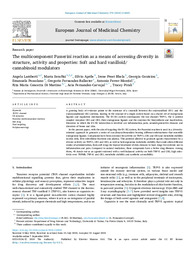Por favor, use este identificador para citar o enlazar este ítem:
https://hdl.handle.net/11000/35243Registro completo de metadatos
| Campo DC | Valor | Lengua/Idioma |
|---|---|---|
| dc.contributor.author | Lamberti, Ángela | - |
| dc.contributor.author | SERAFINI, MARTA | - |
| dc.contributor.author | Aprile, Silvio | - |
| dc.contributor.author | Preet Bhela, Irene | - |
| dc.contributor.author | Goutsiou, Georgia | - |
| dc.contributor.author | Pessolano, Emanuela | - |
| dc.contributor.author | Fernández Ballester, Gregorio | - |
| dc.contributor.author | Ferrer-Montiel, Antonio | - |
| dc.contributor.author | Di Martino, Rita Maria Concetta | - |
| dc.contributor.author | Fernandez-Carvajal, Asia | - |
| dc.contributor.author | PIRALI, Tracey | - |
| dc.contributor.other | Departamentos de la UMH::Bioquímica y Biología Molecular | es_ES |
| dc.date.accessioned | 2025-01-24T12:43:02Z | - |
| dc.date.available | 2025-01-24T12:43:02Z | - |
| dc.date.created | 2024-12 | - |
| dc.identifier.citation | European Journal of Medicinal Chemistry Volume 279, 5 December 2024, 116845 | es_ES |
| dc.identifier.issn | 1768-3254 | - |
| dc.identifier.issn | 0223-5234 | - |
| dc.identifier.uri | https://hdl.handle.net/11000/35243 | - |
| dc.description.abstract | A growing body of evidence points to the existence of a crosstalk between the endovanilloid (EV)- and the endocannabinoid (EC) systems, leading to the concept of a single system based on a shared set of endogenous ligands and regulation mechanisms. The EV/EC system encompasses the ion channel TRPV1, the G protein coupled receptors CB1 and CB2, their endogenous ligands and the enzymes for biosynthesis and inactivation. Disorders in which the EV/EC interaction is involved are inflammation, pain, neurodegenerative diseases and disorders of bones and skin. In the present paper, with the aim of targeting the EV/EC system, the Passerini reaction is used in a diversityoriented approach to generate a series of α-acyloxycarboxamides bearing different substructures that resemble endogenous ligands. Compounds have been screened for activity on TRPV1, CB1 and CB2 and metabolic stability in skin cells, liver subcellular fractions and plasma. This protocol allowed to generate agents characterized by a diverse activity on TRPV1, CB1 and CB2, as well as heterogeneous metabolic stability that could allow different routes of administration, from soft drugs for topical treatment of skin diseases to hard drugs for systemic use in inflammation and pain. Compared to natural mediators, these compounds have a better drug-likeness. Among them, 41 stands out as an agonist endowed with a well-balanced activity on both TRPV1 and CB2, high selectivity over TRPM8, TRPA1 and CB1, metabolic stability and synthetic accessibility. | es_ES |
| dc.format | application/pdf | es_ES |
| dc.format.extent | 21 | es_ES |
| dc.language.iso | eng | es_ES |
| dc.publisher | Elsevier | es_ES |
| dc.rights | info:eu-repo/semantics/openAccess | es_ES |
| dc.rights.uri | http://creativecommons.org/licenses/by-nc-nd/4.0/ | * |
| dc.subject | TRPV1 channel | es_ES |
| dc.subject | CB receptors | es_ES |
| dc.subject | Passerini multicomponent reaction | es_ES |
| dc.subject | Soft drug | es_ES |
| dc.subject | Dual targeting | es_ES |
| dc.subject | Polipharmacology | es_ES |
| dc.subject.other | CDU::5 - Ciencias puras y naturales::57 - Biología | es_ES |
| dc.title | The multicomponent Passerini reaction as a means of accessing diversity in structure, activity and properties: Soft and hard vanilloid/cannabinoid modulators | es_ES |
| dc.type | info:eu-repo/semantics/article | es_ES |
| dc.relation.publisherversion | https://doi.org/10.1016/j.ejmech.2024.116845 | es_ES |

Ver/Abrir:
1-s2.0-S0223523424007268-main.pdf
5,79 MB
Adobe PDF
Compartir:
 La licencia se describe como: Atribución-NonComercial-NoDerivada 4.0 Internacional.
La licencia se describe como: Atribución-NonComercial-NoDerivada 4.0 Internacional.
.png)